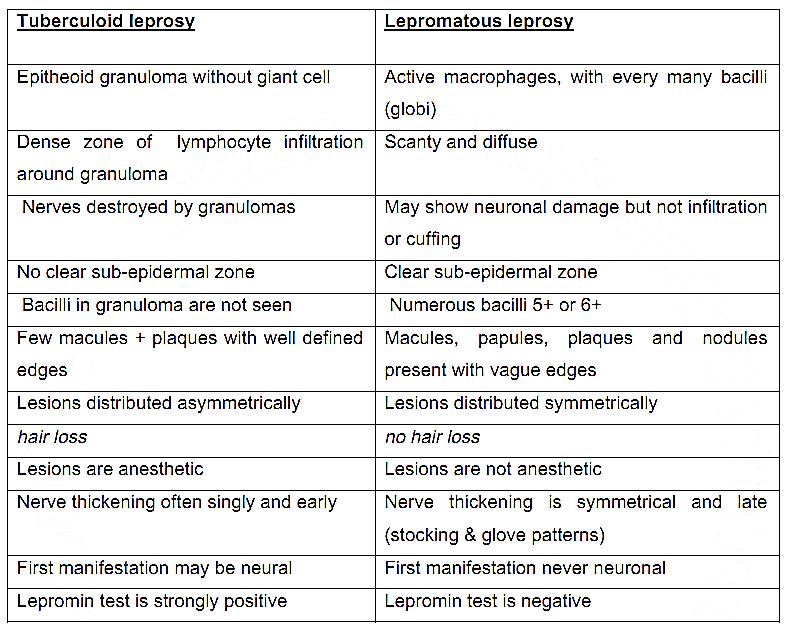


 النبات
النبات
 الحيوان
الحيوان
 الأحياء المجهرية
الأحياء المجهرية
 علم الأمراض
علم الأمراض
 التقانة الإحيائية
التقانة الإحيائية
 التقنية الحيوية المكروبية
التقنية الحيوية المكروبية
 التقنية الحياتية النانوية
التقنية الحياتية النانوية
 علم الأجنة
علم الأجنة
 الأحياء الجزيئي
الأحياء الجزيئي
 علم وظائف الأعضاء
علم وظائف الأعضاء
 الغدد
الغدد
 المضادات الحيوية
المضادات الحيوية|
Read More
Date: 22-2-2016
Date: 22-2-2016
Date: 22-2-2016
|
Leprosy
Definition: Leprosy or Hansen disease is a slowly progressive infection caused by Mycobacterium leprae affecting the skin and peripheral nerves and resulting mainly in deformity, paralysis and ulceration. Though M. leprae is in most part contained in the skin, the disease is believed to be transmitted from person to person through aerosols from lesions in upper respiratory tract.
Pathogenesis:
- The bacillus is acid fast, obligate intracellular organism that does not grow in culture and it grows best at 32-34 0C of the temperature of human skin.
- Like M. tuberculosis, M leprae secrets no toxins but its virulence is based on properties of its cell wall. The bacilli thus produce either potentially destructive granulomas or by interference with the metabolism of cells. The bacilli are taken by alveolar macrophages; disseminate through the blood but grows only in relatively cool tissues of the skin and extremities.
- Classification based on host immune responses. Leprosy is a bipolar disease. Two forms of the disease occur depending on whether the host mounts a T-cell mediated immune response (tuberculoid leprosy) or the host is anergic (lepromatous leprosy). The polar forms are relatively stable but the borderline forms (border line-tuberculoid, borderline-borderline, and borderline-lepromatous) are unstable without treatment. It may usually deteriorate to lepromatous leprosy. Patients with tuberculoid leprosy form granuloma with few surviving bacteria (paucibacillary disease). The 48 hour leporine skin test is strongly positive and this is effected largely by CD4 + type 1 helper T-cell that secretes IL-2 & interferon δ .
- In contrast, patients with lepromatous leprosy lack T-cell mediated immunity, and are anergic to lepromin and have diffuse lesions (globi) containing foamy macrophages, stuffed with large numbers of mycobacteria (multibacillary disease). Lepromatous leprosy lesions lack CD4+ type I T-cell at their margins but in stead contain many CD8+ suppressor T-cell in a diffuse pattern. The CD8+ suppressor T-cell secrete IL-10, which inhibits helper-cells and may mediate the anergy seen in lepromatous leprosy. These CD 8+ suppressors T-cell also secrete IL-4, which induce antibody production by B-cell.
Antibody production is not protective in lepromatous leprosy and rather the formation of antigen antibody complexes in lepromatous leprosy leads to erythema nodosum leprosum, a life threatening vasculitis, and glomerulonephrits
- Because of the diffuse parasite filled lesions lepromatous leprosy is more infectious than those with tuberculoid leprosy.
Table: Differences between tuberculoid and lepomatous leprosy

Clinical course and complications
- Lepromatous leprosy involves primarily the shin, peripheral nerves, anterior eye, upper airways (down to larynx), testis, hands and feet. The vital organs and the central nervous system are rarely affected presumably because the core temperature is too high for the growth of M.leprae.
References
Bezabeh ,M. ; Tesfaye,A.; Ergicho, B.; Erke, M.; Mengistu, S. and Bedane,A.; Desta, A.(2004). General Pathology. Jimma University, Gondar University Haramaya University, Dedub University.



|
|
|
|
لصحة القلب والأمعاء.. 8 أطعمة لا غنى عنها
|
|
|
|
|
|
|
حل سحري لخلايا البيروفسكايت الشمسية.. يرفع كفاءتها إلى 26%
|
|
|
|
|
|
|
جامعة الكفيل تحتفي بذكرى ولادة الإمام محمد الجواد (عليه السلام)
|
|
|